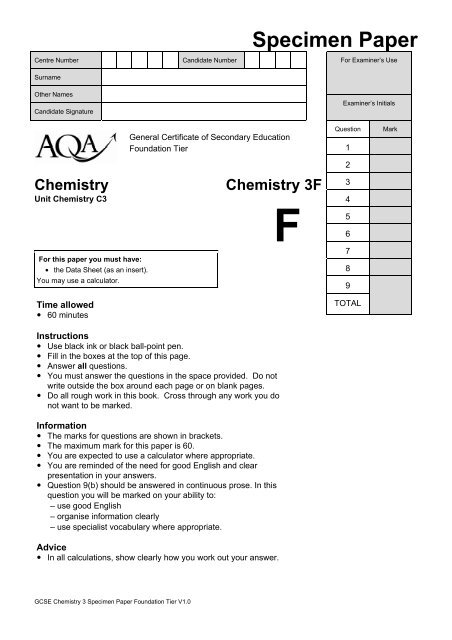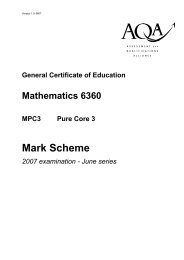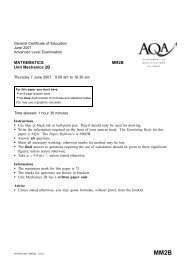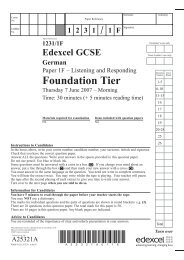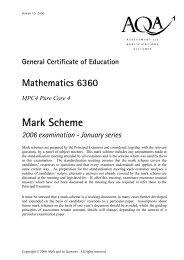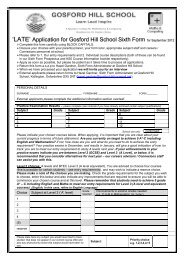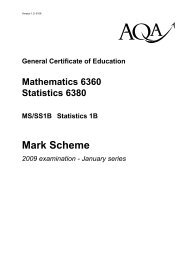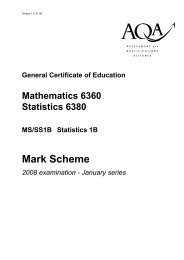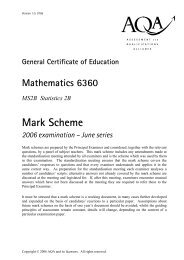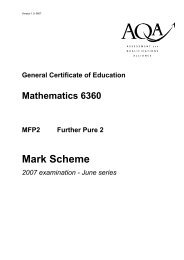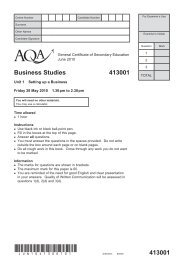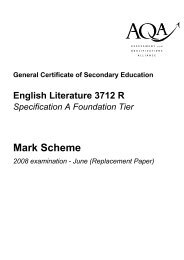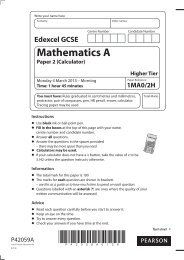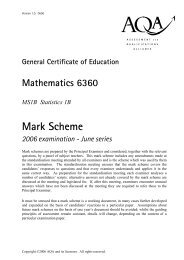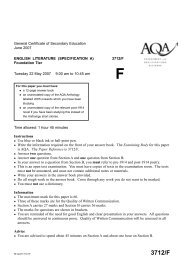GCSE Chemistry Specimen Question Paper Foundation ... - AQA
GCSE Chemistry Specimen Question Paper Foundation ... - AQA
GCSE Chemistry Specimen Question Paper Foundation ... - AQA
You also want an ePaper? Increase the reach of your titles
YUMPU automatically turns print PDFs into web optimized ePapers that Google loves.
Centre Number<br />
Surname<br />
Candidate Number<br />
<strong>Specimen</strong> <strong>Paper</strong><br />
For Examiner’s Use<br />
Other Names<br />
Candidate Signature<br />
Examiner’s Initials<br />
General Certificate of Secondary Education<br />
<strong>Foundation</strong> Tier<br />
<strong>Question</strong><br />
1<br />
Mark<br />
<strong>Chemistry</strong><br />
Unit <strong>Chemistry</strong> C3<br />
For this paper you must have:<br />
• the Data Sheet (as an insert).<br />
You may use a calculator.<br />
Time allowed<br />
! 60 minutes<br />
<strong>Chemistry</strong> 3F<br />
F<br />
2<br />
3<br />
4<br />
5<br />
6<br />
7<br />
8<br />
9<br />
TOTAL<br />
Instructions<br />
! Use black ink or black ball-point pen.<br />
! Fill in the boxes at the top of this page.<br />
! Answer all questions.<br />
! You must answer the questions in the space provided. Do not<br />
write outside the box around each page or on blank pages.<br />
! Do all rough work in this book. Cross through any work you do<br />
not want to be marked.<br />
Information<br />
! The marks for questions are shown in brackets.<br />
! The maximum mark for this paper is 60.<br />
! You are expected to use a calculator where appropriate.<br />
! You are reminded of the need for good English and clear<br />
presentation in your answers.<br />
! <strong>Question</strong> 9(b) should be answered in continuous prose. In this<br />
question you will be marked on your ability to:<br />
– use good English<br />
– organise information clearly<br />
– use specialist vocabulary where appropriate.<br />
Advice<br />
! In all calculations, show clearly how you work out your answer.<br />
<strong>GCSE</strong> <strong>Chemistry</strong> 3 <strong>Specimen</strong> <strong>Paper</strong> <strong>Foundation</strong> Tier V1.0
2<br />
Do not write<br />
outside the<br />
box<br />
Answer all questions in the spaces provided.<br />
1 In 1869, a scientist put the 60 known elements into his periodic table.<br />
Draw a ring around the correct answer to complete each sentence.<br />
Boyle.<br />
1 (a) The scientist who put these elements into a periodic table was<br />
Mendeleev.<br />
Newlands.<br />
(1 mark)<br />
atomic weight.<br />
1 (b) First he put the 60 known elements in order of their<br />
boiling point.<br />
electrical conductivity.<br />
(1 mark)<br />
groups.<br />
1 (c) Then he put elements with similar chemical properties in columns, known as<br />
periods.<br />
rows.<br />
(1 mark)<br />
<strong>GCSE</strong> <strong>Chemistry</strong> 3 <strong>Specimen</strong> <strong>Paper</strong> <strong>Foundation</strong> Tier V1.0
3<br />
Do not write<br />
outside the<br />
box<br />
uncommon.<br />
1 (d) His periodic table had gaps for elements that were<br />
undiscovered.<br />
unreactive.<br />
(1 mark)<br />
1 (e) From 1900 onwards, the modern periodic table was produced.<br />
The modern periodic table is an arrangement of elements<br />
electronic structures.<br />
in terms of their<br />
neutron numbers.<br />
atomic weights.<br />
(1 mark)<br />
5<br />
Turn over for the next question<br />
<strong>GCSE</strong> <strong>Chemistry</strong> 3 <strong>Specimen</strong> <strong>Paper</strong> <strong>Foundation</strong> Tier V1.0<br />
Turn over !
4<br />
Do not write<br />
outside the<br />
box<br />
2 Sodium is in Group 1 of the periodic table.<br />
2 (a) Here are some statements about sodium.<br />
Which two of these statements are correct?<br />
Tick (!) two boxes.<br />
Statement Tick (!)<br />
Sodium is a metal.<br />
Sodium is a halogen.<br />
Sodium forms an ion with a +1 charge.<br />
Sodium forms covalent compounds.<br />
(2 marks)<br />
2 (b) Sodium reacts with water.<br />
A student drew this diagram and wrote the observations A, B, C and D about the<br />
reaction between sodium and water.<br />
A The sodium floated and started giving off a gas.<br />
B The sodium melted.<br />
C The piece of sodium became smaller until all the sodium had gone.<br />
D A colourless solution was left.<br />
Use these observations to answer parts (i) and (ii).<br />
2 (b) (i) Which observation, A, B, C or D, shows that sodium has a low density?<br />
(1 mark)<br />
<strong>GCSE</strong> <strong>Chemistry</strong> 3 <strong>Specimen</strong> <strong>Paper</strong> <strong>Foundation</strong> Tier V1.0
5<br />
Do not write<br />
outside the<br />
box<br />
2 (b) (ii) Which observation, A, B, C or D, shows that the reaction is exothermic?<br />
(1 mark)<br />
2 (b) (iii) What is the name of the gas given off in this reaction?<br />
............................................................................................................................................<br />
(1 mark)<br />
5<br />
Turn over for the next question<br />
<strong>GCSE</strong> <strong>Chemistry</strong> 3 <strong>Specimen</strong> <strong>Paper</strong> <strong>Foundation</strong> Tier V1.0<br />
Turn over !
6<br />
Do not write<br />
outside the<br />
box<br />
3 Water is a natural resource.<br />
3 (a) Water in some parts of the UK is hard, but in other parts of the UK it is soft.<br />
Draw a ring around the correct answer to complete each sentence.<br />
condense<br />
3 (a) (i) Water becomes hard because ions in rocks dissolve into the water.<br />
evaporate<br />
(1 mark)<br />
calcium<br />
3 (a) (ii) Hardness in water is caused by hydrogen ions.<br />
sodium<br />
(1 mark)<br />
3 (b) There are two types of hard water, permanent hard water and temporary hard water.<br />
Draw a straight line from each statement to the correct type of water.<br />
Statement<br />
Type of water<br />
Permanent hard water<br />
Easily makes a lather with soap<br />
Temporary hard water<br />
Can be made soft by boiling<br />
Soft water<br />
(2 marks)<br />
<strong>GCSE</strong> <strong>Chemistry</strong> 3 <strong>Specimen</strong> <strong>Paper</strong> <strong>Foundation</strong> Tier V1.0
7<br />
Do not write<br />
outside the<br />
box<br />
3 (c) Water of the correct quality is essential for life.<br />
In many parts of the world the water used for drinking contains solid particles and<br />
harmful bacteria.<br />
Suggest two methods that could be used to improve the quality of this water.<br />
1 ..........................................................................................................................................<br />
2 ..........................................................................................................................................<br />
(2 marks)<br />
6<br />
Turn over for the next question<br />
<strong>GCSE</strong> <strong>Chemistry</strong> 3 <strong>Specimen</strong> <strong>Paper</strong> <strong>Foundation</strong> Tier V1.0<br />
Turn over !
8<br />
Do not write<br />
outside the<br />
box<br />
4 Ammonia is used in the production of fertilisers. The flow diagram shows the main stages<br />
in the manufacture of ammonia.<br />
Study the flow diagram and then answer the questions.<br />
Gas X<br />
(separated<br />
from air)<br />
Gas Y<br />
(made from<br />
methane)<br />
Compressor<br />
Reactor<br />
Unreacted gases<br />
Condenser<br />
Ammonia<br />
4 (a) (i) Name gas X and name gas Y.<br />
Gas X is……………………………………..Gas Y is………………………….….<br />
(2 marks)<br />
4 (a) (ii) Draw a ring around the correct answer to complete the sentence.<br />
cooled<br />
In the condenser the mixture is<br />
heated<br />
oxidised<br />
to separate ammonia as a liquid.<br />
(1 mark)<br />
4 (b) The ammonia is separated as a liquid from the unreacted gases.<br />
Suggest two reasons why the unreacted gases are recycled.<br />
............................................................................................................................................<br />
............................................................................................................................................<br />
............................................................................................................................................<br />
............................................................................................................................................<br />
(2 marks)<br />
<strong>GCSE</strong> <strong>Chemistry</strong> 3 <strong>Specimen</strong> <strong>Paper</strong> <strong>Foundation</strong> Tier V1.0
9<br />
Do not write<br />
outside the<br />
box<br />
4 (c) The graph shows the percentage of ammonia made at different temperatures and<br />
pressures.<br />
Study the graph and then answer the questions.<br />
4 (c) (i) Draw a ring around the correct answers to complete the sentence.<br />
To make the greatest percentage yield of ammonia<br />
low<br />
low.<br />
the temperature should be<br />
medium<br />
and the pressure should be<br />
medium.<br />
high<br />
high.<br />
(2 marks)<br />
4 (c) (ii) What is the percentage yield of ammonia at a temperature of 450°C and at a pressure of<br />
200 atmospheres?<br />
................................................... %<br />
(1 mark)<br />
<strong>Question</strong> 4 continues on the next page<br />
<strong>GCSE</strong> <strong>Chemistry</strong> 3 <strong>Specimen</strong> <strong>Paper</strong> <strong>Foundation</strong> Tier V1.0<br />
Turn over !
10<br />
Do not write<br />
outside the<br />
box<br />
4 (c) (iii) Ammonia is often made at a temperature of 450°C and at a pressure of 200<br />
atmospheres.<br />
Suggest two reasons why it is economical to make ammonia using these conditions.<br />
............................................................................................................................................<br />
............................................................................................................................................<br />
............................................................................................................................................<br />
............................................................................................................................................<br />
(2 marks)<br />
10<br />
<strong>GCSE</strong> <strong>Chemistry</strong> 3 <strong>Specimen</strong> <strong>Paper</strong> <strong>Foundation</strong> Tier V1.0
11<br />
Do not write<br />
outside the<br />
box<br />
5 The structures shown are of the first two members of a homologous series of organic<br />
compounds.<br />
H H H<br />
H C O H H C C O H<br />
H H H<br />
Methanol<br />
Ethanol<br />
5 (a) (i) Complete the diagram for propanol, the next member of the homologous series.<br />
C C C<br />
Propanol<br />
(1 mark)<br />
5 (a) (ii) Which one of the statements about ethanol is correct?<br />
Tick (!) one box.<br />
Statement Tick (!)<br />
Ethanol dissolves in water to form a neutral solution.<br />
Ethanol reacts with sodium to produce chlorine.<br />
Ethanol does not burn in air.<br />
(1 mark)<br />
5 (b) Ethanoic acid (CH 3 COOH) can be produced from ethanol (CH 3 CH 2 OH).<br />
5 (b) (i) What type of reaction happens when ethanoic acid is produced from ethanol?<br />
............................................................................................................................................<br />
(1 mark)<br />
5 (b) (ii) State one use of ethanoic acid.<br />
............................................................................................................................................<br />
(1 mark)<br />
4<br />
<strong>GCSE</strong> <strong>Chemistry</strong> 3 <strong>Specimen</strong> <strong>Paper</strong> <strong>Foundation</strong> Tier V1.0<br />
Turn over !
12<br />
Do not write<br />
outside the<br />
box<br />
6 The use of too much common salt (sodium chloride) in our diet increases the risk of heart<br />
problems. One way to reduce sodium chloride in our diet is to use Low Sodium Salt<br />
instead of common salt.<br />
A student tested Low Sodium Salt to find out if it contained all of the compounds on the<br />
list of ingredients.<br />
6 (a) The student added dilute hydrochloric acid to Low Sodium Salt to show that it contains<br />
carbonate ions. Carbon dioxide gas was given off.<br />
6 (a) (i) What would the student see that shows a gas is given off?<br />
............................................................................................................................................<br />
............................................................................................................................................<br />
(1 mark)<br />
6 (a) (ii) The student tested the gas given off to show that the gas was carbon dioxide.<br />
Complete the sentence.<br />
When carbon dioxide gas is mixed with limewater<br />
the solution turns .................................................. .<br />
(1 mark)<br />
6 (b) The student tested for magnesium ions. The student added sodium hydroxide solution to<br />
a solution of Low Sodium Salt.<br />
What is the colour of the precipitate that the student would see?<br />
............................................................................................................................................<br />
(1 mark)<br />
<strong>GCSE</strong> <strong>Chemistry</strong> 3 <strong>Specimen</strong> <strong>Paper</strong> <strong>Foundation</strong> Tier V1.0
13<br />
Do not write<br />
outside the<br />
box<br />
6 (c) The student did a flame test using Low Sodium Salt.<br />
6 (c) (i) The flame colour the student saw was yellow. Which compound in Low Sodium Salt<br />
produces this flame colour?<br />
............................................................................................................................................<br />
(1 mark)<br />
6 (c) (ii) The student did not observe the colour in the flame which would show that there were<br />
potassium ions in the Low Sodium Salt.<br />
Suggest why.<br />
(You will need to state the flame colour of the potassium ions in your answer.)<br />
............................................................................................................................................<br />
............................................................................................................................................<br />
............................................................................................................................................<br />
............................................................................................................................................<br />
(2 marks)<br />
6<br />
Turn over for the next question<br />
<strong>GCSE</strong> <strong>Chemistry</strong> 3 <strong>Specimen</strong> <strong>Paper</strong> <strong>Foundation</strong> Tier V1.0<br />
Turn over !
14<br />
Do not write<br />
outside the<br />
box<br />
7 The table shows information about the halogens in Group 7 of the periodic table.<br />
Name of halogen Melting point in °C Boiling point in °C Electronic structure<br />
Fluorine –220 –188<br />
....................................<br />
Chlorine –101 0–35 2,8,7<br />
Bromine 00–7 0+58 2,8,18,7<br />
Iodine +114 +183 2,8,18,18,7<br />
7 (a) Use information from the table to help you to answer these questions.<br />
7 (a) (i) Name one halogen that is a solid at 25 °C.<br />
7 (a) (ii) Name one halogen that is a gas at 25 °C.<br />
........................................................<br />
(1 mark)<br />
........................................................<br />
(1 mark)<br />
7 (a) (iii) Use the periodic table on the Data Sheet to help you to work out the correct electronic<br />
structure for fluorine. Write your answer in the table above.<br />
(1 mark)<br />
7 (a) (iv) Use the periodic table on the Data Sheet to name one Group 7 element that is not<br />
shown in the table above.<br />
........................................................<br />
(1 mark)<br />
7 (b) A teacher demonstrated the reactivity of the halogens to some students.<br />
Halogen vapour was passed over heated iron wool in a fume cupboard.<br />
<strong>GCSE</strong> <strong>Chemistry</strong> 3 <strong>Specimen</strong> <strong>Paper</strong> <strong>Foundation</strong> Tier V1.0
15<br />
Do not write<br />
outside the<br />
box<br />
The teacher’s observations are shown in the table below.<br />
During the reaction<br />
Observations<br />
After the reaction<br />
Bromine The iron wool glowed A red–brown solid had been produced<br />
Chlorine The iron wool glowed brightly A dark brown solid had been produced<br />
Iodine The iron wool did not glow A black solid had been produced<br />
7 (b) (i) What is the order of reactivity of these three halogens?<br />
Order of reactivity: most reactive halogen 1 ...................................................................<br />
2 ..................................................................<br />
least reactive halogen 3 ...................................................................<br />
(1 mark)<br />
7 (b) (ii) Explain how you used the teacher’s observations to decide your order of reactivity.<br />
............................................................................................................................................<br />
............................................................................................................................................<br />
............................................................................................................................................<br />
............................................................................................................................................<br />
(2 marks)<br />
7<br />
Turn over for the next question<br />
Turn over !<br />
<strong>GCSE</strong> <strong>Chemistry</strong> 3 <strong>Specimen</strong> <strong>Paper</strong> <strong>Foundation</strong> Tier V1.0
16<br />
Do not write<br />
outside the<br />
box<br />
There are no questions printed on this page<br />
DO NOT WRITE ON THIS PAGE<br />
ANSWER IN THE SPACES PROVIDED<br />
<strong>GCSE</strong> <strong>Chemistry</strong> 3 <strong>Specimen</strong> <strong>Paper</strong> <strong>Foundation</strong> Tier V1.0
17<br />
Do not write<br />
outside the<br />
box<br />
8 Methanol can be made when methane reacts with oxygen.<br />
8 (a) The energy level diagram for this reaction is shown below.<br />
8 (a) (i) What is the energy change represented by A?<br />
............................................................................................................................................<br />
(1 mark)<br />
8 (a) (ii) Use the energy level diagram to explain how it shows that this reaction is exothermic.<br />
............................................................................................................................................<br />
............................................................................................................................................<br />
............................................................................................................................................<br />
............................................................................................................................................<br />
(2 marks)<br />
<strong>Question</strong> 8 continues on the next page<br />
<strong>GCSE</strong> <strong>Chemistry</strong> 3 <strong>Specimen</strong> <strong>Paper</strong> <strong>Foundation</strong> Tier V1.0<br />
Turn over !
18<br />
Do not write<br />
outside the<br />
box<br />
8 (b) A student did an experiment to find the energy released when methanol burns in air.<br />
The student:<br />
• weighed a spirit burner containing methanol<br />
• set up the equipment as shown in the diagram<br />
• recorded the initial temperature<br />
• lit the spirit burner<br />
• put out the flame when the temperature of the water had risen by about 20 o C<br />
• stirred the water and recorded the highest temperature of the water<br />
• reweighed the spirit burner containing the methanol.<br />
The student repeated the experiment and recorded his results.<br />
Initial mass of spirit<br />
burner and methanol in g<br />
Final mass of spirit<br />
burner and methanol in g<br />
Initial temperature<br />
in o C<br />
Highest temperature<br />
in o C<br />
Experiment 1 Experiment 2 Experiment 3<br />
299.3 298.3 296.9<br />
298.3 297.1 295.9<br />
23 22 23<br />
45 50 43<br />
Temperature change in o C 22 28 20<br />
Use the diagram and the information in the table to answer the questions.<br />
8 (b) (i) The main error in this experiment is energy loss.<br />
Suggest one way that the equipment could be changed to reduce energy loss.<br />
............................................................................................................................................<br />
(1 mark)<br />
<strong>GCSE</strong> <strong>Chemistry</strong> 3 <strong>Specimen</strong> <strong>Paper</strong> <strong>Foundation</strong> Tier V1.0
19<br />
Do not write<br />
outside the<br />
box<br />
8 (b) (ii) The temperature change in Experiment 2 is greater than the temperature change in<br />
Experiment 1 and Experiment 3.<br />
Explain why.<br />
............................................................................................................................................<br />
............................................................................................................................................<br />
............................................................................................................................................<br />
............................................................................................................................................<br />
(2 marks)<br />
8 (b) (iii) Suggest one reason why the student repeated the experiment.<br />
............................................................................................................................................<br />
............................................................................................................................................<br />
(1 mark)<br />
8 (b) (iv) Use the temperature change in Experiments 1 and 3 to calculate how much energy is<br />
released when 1g of methanol burns. The equation that you need to use is:<br />
Energy released in joules = 100 x 4.2 x mean temperature change<br />
Show clearly how you work out your answer.<br />
............................................................................................................................................<br />
............................................................................................................................................<br />
............................................................................................................................................<br />
Burning 1g of methanol releases ...................................... J<br />
(2 marks)<br />
9<br />
Turn over for the next question<br />
<strong>GCSE</strong> <strong>Chemistry</strong> 3 <strong>Specimen</strong> <strong>Paper</strong> <strong>Foundation</strong> Tier V1.0<br />
Turn over !
20<br />
Do not write<br />
outside the<br />
box<br />
9 Drain Buster is used to clear and degrease drains. Sodium hydroxide is the main<br />
chemical substance in Drain Buster.<br />
9 (a) A student planned an experiment to find the concentration of the sodium hydroxide<br />
solution in Drain Buster.<br />
The teacher had to dilute the Drain Buster before the student could use it.<br />
Explain why.<br />
............................................................................................................................................<br />
............................................................................................................................................<br />
............................................................................................................................................<br />
............................................................................................................................................<br />
(2 marks)<br />
<strong>GCSE</strong> <strong>Chemistry</strong> 3 <strong>Specimen</strong> <strong>Paper</strong> <strong>Foundation</strong> Tier V1.0
21<br />
Do not write<br />
outside the<br />
box<br />
9 (b) In this question you will be assessed on using good English, organising information<br />
clearly and using specialist terms where appropriate.<br />
The student wanted to find the volume of hydrochloric acid that reacts with a known<br />
volume of diluted Drain Buster.<br />
Describe how the student could do this by titration.<br />
In your description you should include:<br />
• the names of pieces of apparatus used<br />
• the names of the substances used<br />
• a risk assessment.<br />
............................................................................................................................................<br />
............................................................................................................................................<br />
............................................................................................................................................<br />
............................................................................................................................................<br />
............................................................................................................................................<br />
............................................................................................................................................<br />
............................................................................................................................................<br />
............................................................................................................................................<br />
............................................................................................................................................<br />
............................................................................................................................................<br />
............................................................................................................................................<br />
............................................................................................................................................<br />
............................................................................................................................................<br />
............................................................................................................................................<br />
(6 marks)<br />
8<br />
END OF QUESTIONS<br />
<strong>GCSE</strong> <strong>Chemistry</strong> 3 <strong>Specimen</strong> <strong>Paper</strong> <strong>Foundation</strong> Tier V1.0
22<br />
Do not write<br />
outside the<br />
box<br />
There are no questions printed on this page<br />
DO NOT WRITE ON THIS PAGE<br />
ANSWER IN THE SPACES PROVIDED<br />
ACKNOWLEDGEMENT OF COPYRIGHT HOLDERS AND PUBLISHERS<br />
Permission to reproduce all copyright material has been applied for. In some cases, efforts to contact copyright-holders have been<br />
unsuccessful and <strong>AQA</strong> will be happy to rectify any omissions of acknowledgements in future papers if notified.<br />
<strong>Question</strong> 1: Photograph © RIA NOVOSTI / SCIENCE PHOTO LIBRARY<br />
Copyright © 2011 <strong>AQA</strong> and its licensors. All rights reserved<br />
<strong>GCSE</strong> <strong>Chemistry</strong> 3 <strong>Specimen</strong> <strong>Paper</strong> <strong>Foundation</strong> Tier V1.0


